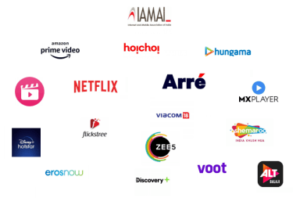The Internet and Mobile Association of India (IAMAI) on Friday i.e. September 4, 2020 unveiled the Universal Self-Regulation Code for OCCPs (“Code”). The Code has been adopted by 15 leading Online Curated Content Providers in India. The present set of signatories include Zee5, Viacom 18, Disney Hotstar, Amazon Prime Video, Netflix, MX Player, Jio Cinema, Eros Now, Alt Balaji, Arre, HoiChoi, Hungama, Shemaroo, Discovery Plus, Flickstree.
The press release issued by IAMAI states:
“The goal of this industry-wide effort is to empower consumers with information and tools to assist them in making informed choice with regard to viewing decisions for them and their families, while at the same time, nurturing creativity and providing creators the freedom to tell the finest stories. By aiming to do what is best for both consumers and creators as guiding principles, the Code intends for India to be one of the most dynamic and fastest growing entertainment industries in the world. To give consumers more choice and control, the Universal Self-Regulation Code includes a framework for age classification and content descriptions for titles as well as access control tools. The Code also introduces a clear, transparent and structured grievance redressal and escalation mechanism for reporting non-compliance with the prescribed guidelines. As a part of this mechanism, each OCCP will set-up a Consumer Complaints Department and/or an internal committee as well as advisory panel which will deal with complaints, appeals and escalations. The advisory panel will constitute a minimum of three members, including an independent external advisor and two senior executives of the respective OCCP.”
The Code is effective from 15 August 2020 and allows OCCPs to comply with all the guidelines in a timebound manner. Each signatory to the code has agreed to appoint an external advisor as part of the grievance redressal mechanism within 60 days.
[Note: It is unclear as to whether the Code is applicable retrospectively from 15th August, 2020 as mentioned in the press release or from the date of the Code i.e. 4th September, 2020]
Some key highlights of the Code:
(i) The Code distinguishes some features of online curated content providers (“OCCP”) such as Online content being provided to consumer on a “pull basis” rather than a “push basis” which means the consumer makes a choice of “pulling” content on the basis of detailed information provided by the services. Such content hence being private exhibition and not “public exhibition”. Such content being typically available subject to certain user-initiated access controls.
(ii) OCCP will enable consumers to make an informed choice about the licensed video content they engage with or the video content they create. This will be done by OCCP by inter-alia adhering to certain disclosures such as, specifying maturity ratings and content descriptors (e.g., language, sex, violence).
(iii) There would be a framework for age classification.
(iv) There would be appropriate content descriptions.
(v) There would be technology enabled access controls
(vi) There would be a Grievance Redressal Mechanism by all signatory OCCP providing a mechanism for grievance redressal and escalation to address grievances of consumers in respect of curated content.
(vii)Each OCCP shall set up its own Consumer Complaints Department, Appellate Committee and Advisory Panel.
(viii) There would be a procedure provided for filing/ withdrawing complaints and timelines provided for the grievance redressal.
(ix) Each OCCP shall maintain records of the complaints and share it with MEITY/ MIB when asked for.
(x) The Code is applicable only for OCCP and not UGC platforms.
Earlier coverage:
(i) The First IAMAI Code which was signed by some of the OTT Platforms in January 2019 was covered here on the blog.
(ii) The second IAMAI Code which sparked some controversies due to its introduction of DCCC was covered here on the blog.
The current code which seems to have been uniformly accepted by most platforms seems to be a step in the right direction. The norms applicable for television broadcasting cannot be applied or placed at par with the content being narrowcasted to viewers through video on demand online services which the Code rightly clarifies as a “Pull” service as against a “Push” service. Viewers have a choice to search and watch the content they wish to and make an informed decision. The I&B Ministry has rightly accepted that it does not have any jurisdiction to regulate OTT Content.
Image source: here.


















![BREAKING: PRESIDENT BRINGS OTT CONTENT WITHIN THE AMBIT OF I&B MINISTRY BY AMENDING THE GOI ALLOCATION OF BUSINESS RULES, 1961 [READ NOTIFICATION]](https://iprmentlaw.com/wp-content/uploads/2020/11/self-regulation-code-for-ott-platforms-a-need-of-the-hour-678x381-1-100x70.jpg)